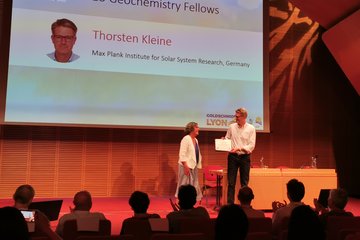Alle Typen
21.
Zeitschriftenartikel
Nonlinear stationary whistler waves and whistler solitons (oscillitons): Exact solutions. Journal of Plasma Physics 69, S. 305 - 330 (2003)
22.
Zeitschriftenartikel
Solitons, oscillitons and stationary waves in a cold p-α plasma. Journal Geophysical Research 107 (A7), 1295 (2003)
23.
Zeitschriftenartikel
Solitons, oscillitons and stationary waves in a warm p-α plasma. Journal Geophysical Research 107 (A7), 1296 (2003)
24.
Zeitschriftenartikel
Dispersion analysis of ULF waves in the foreshock using Cluster data and the wave telescope technique. Geophysical Research Letters 30, 1710 (2003)
25.
Zeitschriftenartikel
Oscillitons and gyrating ions in a beam-plasma system. Geophysical Research Letters 30, 2192 (2003)
26.
Zeitschriftenartikel
Solitons and oscillitons in multi-ion space plasmas. Nonlinear Processes in Geophysics 10, S. 121 - 130 (2003)
27.
Zeitschriftenartikel
Solitons and oscillitons in cold bi-ion plasmas: a parameter study. Journal of Plasma Physics 68, S. 27 - 52 (2002)
28.
Zeitschriftenartikel
Nonlinear waves and solitons propagating perpendicular to the magnetic field in bi-ion plasma with finite plasma pressure. Nonlinear Processes in Geophysics 9, S. 87 - 99 (2002)
29.
Zeitschriftenartikel
Coherent waves in multi-ion plasmas. Physica Scripta T98, S. 52 - 57 (2002)
30.
Zeitschriftenartikel
Wave emissions by whistler oscillitons. Application to coherent lion roars. Geophysical Research Letters 29 (24), 2226 (2002)
31.
Zeitschriftenartikel
Nonlinear waves propagating transverse to the magnetic field. Journal of Plasma Physics 65, S. 213 - 233 (2001)
32.
Zeitschriftenartikel
Stationary waves in a bi-ion plasma transverse to the magnetic field. Journal of Plasma Physics 65, S. 197 - 212 (2001)
33.
Zeitschriftenartikel
New type of soliton in bi-ion plasmas and possible implications. Geophysical Research Letters 28, S. 3589 - 3592 (2001)
34.
Zeitschriftenartikel
Multi-instrument study of the upstream region near Mars: Phobos-2 observations. Journal Geophysical Research 105, S. 7557 - 7571 (2000)
35.
Zeitschriftenartikel
Deceleration of the solar wind upstream of the Martian bow schock. Mass-loading or foreshock features? Advances in Space Research 26, S. 1627 - 1631 (2000)
36.
Zeitschriftenartikel
The nature of the martian 'obstacle boundary'. Advances in Space Research 26, S. 1633 - 1637 (2000)
37.
Zeitschriftenartikel
Physics of mass loaded plasmas. Space Science Reviews 94, S. 429 - 671 (2000)
38.
Zeitschriftenartikel
The Martian magnetosphere - a laboratory for bi-ion plasma investigations. Astrophysics and Space Science 264, S. 273 - 288 (1999)
39.
Zeitschriftenartikel
The IMF control of the Martian bow shock and plasma flow in the magnetosheath. Predictions of 3D simulations and observations. Earth, Planets and Space 50, S. 873 - 882 (1999)
40.
Zeitschriftenartikel
The IMF control of the Martian bow shock and plasma flow in the magnetosheath. Predictions of 3D simulations and observations. Earth, Moon and Planets 50, S. 873 - 882 (1999)











